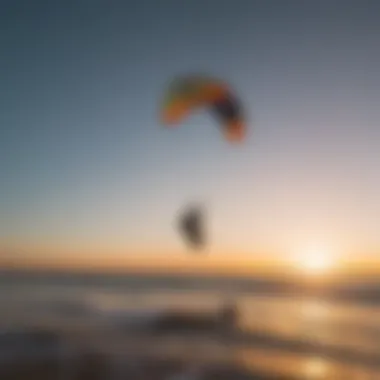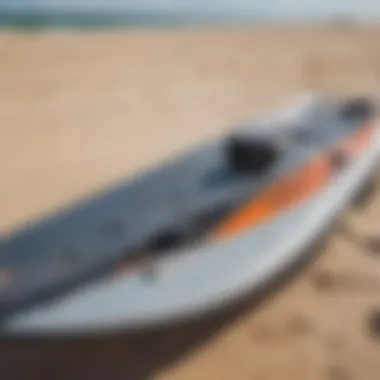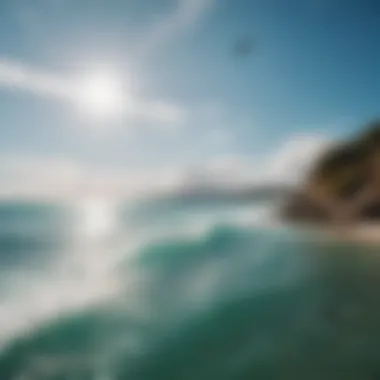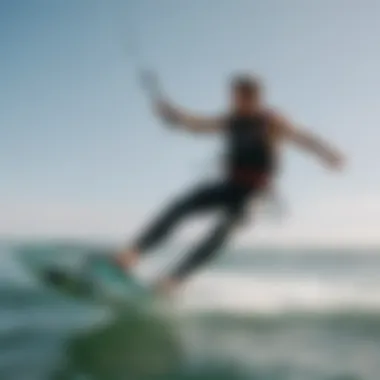Exploring the Dynamic World of Wing Kitesurfing


Intro
Wing kitesurfing is carving its own niche in the broader landscape of kiteboarding. Many are drawn to it, not merely for the thrill of gliding across water but also for the flexibility it offers. This discipline combines elements of both kitesurfing and windsurfing, harnessing wind power with a unique wing design that provides unmatched control for both seasoned riders and newcomers alike.
Recognizing the roots of this sport can anchor a rider's appreciation for it. Beginning in relatively recent years, wing kitesurfing has seen remarkable growth, propelled by innovations in equipment and design. It has evolved, from its experimental stages into a recognized sport with its own set of dedicated enthusiasts.
The heart of wing kitesurfing lies in two crucial areas: gear selection and skill development. Understanding the intricacies of the equipment, as well as mastering the techniques, can significantly transform a rider's experience on the water. This exploration serves not just as an informative guide, but as a doorway to enhance one’s proficiency and enjoyment.
Let's delve into the vital components that form the foundation of wing kitesurfing, starting with the essential gear.
Understanding Wing Kitesurfing
Wing kitesurfing is catching on like wildfire in the world of watersports. It's not just about riding on the waves or cruising through the winds; it's about embracing a whole new method of connecting with nature. Whether you're a seasoned pro or just dipping your toes in, comprehending wing kitesurfing is essential to fully appreciate what this sport offers.
Definition and Terminology
At its core, wing kitesurfing combines elements from traditional kiteboarding and windsurfing. The term “wing” refers to the inflatable sail that is held in the hands, giving the rider total control over direction, lift, and speed. Unlike kites that are tethered to the ground, a wing operates freely, allowing for more maneuvers and adaptability.
Key terms to be familiar with include:
- Wing: The sail-like structure used to harness wind power.
- Board: The platform upon which the rider stands, like a surf or paddleboard.
- Foil: An underwater propulsion system that lifts the board above the water, providing a smooth ride.
- Tack: Changing direction while riding.
Understanding these terms lays down a foundation for riders, enabling better communication about techniques and equipment.
Historical Context and Evolution
The practice of wing kitesurfing didn’t pop up overnight. It can be traced back to the innovations in windsurfing and kiteboarding. In the early 2000s, the idea of using a handheld wing started to gain traction, prominently promoted through videos shared on platforms like Facebook and Reddit. As technology advanced, materials became lighter and more durable, making wings easier to handle and more accessible for beginners.
Developers noticed a gap in the market, especially when kitesurfers wanted to cross over from traditional styles. Before long, wing kitesurfing evolved into a distinct discipline. Its growth shot through the roof culminating in events and competitions that spotlighted this exciting sport across the globe. Riders can now enjoy a multifaceted experience, from the pristine beaches of Maui to the windy coasts of France, shaping local kitesurfing communities.
Comparisons with Traditional Kiteboarding
While both sports share a similar essence, wing kitesurfing and traditional kiteboarding differ in various ways. For starters, while kiteboarding relies heavily on a fixed point and large kite, wing kitesurfing offers a more free-spirited approach, giving riders increased mobility. The simplicity of the wing empowers riders to launch and land with more ease, reducing the setup time before hitting the water.
Here are some notable distinctions:
- Launching and Landing: Wings can be launched even in gusty winds, making it easier for riders to get going.
- Water Start: Many find it easier to start off the water with a wing compared to traditional kites, which often require more technique and skill.
- Maneuverability: The ability to pivot and redirect quickly can give riders an edge when navigating challenging winds and waves.
Generally, riders may find one option more appealing based on personal preferences and their approach to the sport. Understanding these nuances will help enthusiasts choose the best path for their own kitesurfing journey.
Equipment Essentials
When it comes to wing kitesurfing, the right equipment is as crucial as the skills required to ride the waves. Having suitable gear enhances not only performance but also safety on the water. This section explores the vital elements of wing kitesurfing equipment, ensuring riders are well-prepared to take on the challenges of this exhilarating sport.


Wings: Types and Specifications
Wings are at the heart of wing kitesurfing. Their design and specifications differ, making it essential for riders to understand which type suits their style and skill level. Here are the main types:
- Inflatable Wings: These wings have a robust construction, allowing for a stable ride even in choppy waters. They typically feature an air bladder, making them buoyant and easier to launch. Ideal for beginners who want a forgiving ride.
- Rigid Wings: Constructed from hard materials, rigid wings offer excellent power and responsiveness. They can generate significant lift and are preferred by seasoned riders looking for a performance edge. However, they may require more skill to handle effectively.
- Foil Wings: Designed for high speeds and enhanced lifting capabilities, foil wings excel in lighter winds. These wings are often favored by experienced kitesurfers who seek to maximize their performance in various conditions.
Choosing the right wing involves considering factors like wind strength, personal riding style, and the type of water conditions expected.
Boards Suitable for Wing Kitesurfing
Selecting an appropriate board is just as vital as choosing the right wing. The board type dictates the rider's ability to maneuver and generate speed. Here's a look at some common options:
- Foil Boards: These boards are fitted with a hydrofoil that lifts above the water surface once sufficient speed is achieved, reducing drag and allowing for a smooth, gliding experience. They're great for those who want to experience a unique sensation while riding.
- Freestyle Boards: These boards are designed for tricks and jumps, often featuring a more flexible build and a sizable surface area for better stability during aerial maneuvers.
- All-Round Boards: A practical choice for various conditions, all-round boards blend features from other categories, providing a balance between speed and stability. Ideal for beginners and those still finding their preferred riding style.
Riders must align their choice of board with their goals, whether it be freestyle, cruising, or racing on the waves.
Safety Gear and Accessories
Safety should never be an afterthought in sports as thrilling as kitesurfing. While the exhilaration of flight is unmatched, ensuring that one is well protected is paramount. Here is a list of essential safety gear:
- Impact Vest: This provides additional buoyancy and protects the torso during falls. A quality vest can help minimize injuries, especially for those exploring jumps or tricks.
- Helmet: Wearing a helmet is crucial. It shields the head from impacts with the water or equipment, particularly important in crowded areas.
- Leash System: A leash connects the wing to the rider, ensuring that if they fall off their board, they can retrieve the wing quickly, reducing the risk of it blowing away.
- Personal Flotation Device (PFD): Although not always mandatory, a PFD can be a lifesaver in case of sudden emergencies or challenging conditions.
"Safety doesn’t happen by accident; it’s a choice riders make every time they hit the water."
Investing in quality safety gear not only boosts confidence but can also make the difference between a fun day on the water and a mishap that puts a damper on the experience.
In sum, focusing on the essential equipment for wing kitesurfing enriches the overall experience. Choosing the right wings, boards, and safety gear lays a strong foundation for any rider looking to master this thrilling sport.
Techniques and Skills Development
In wing kitesurfing, mastering techniques and skill development is vital. It goes beyond just knowing how to ride; it shapes the overall experience and safety of the sport. Building a solid foundation in technique can greatly impact performance, allowing riders to maneuver with finesse and confidence. This reality comes into play whether you're catching your first wave or nailing a complex trick.
Further, as with any sport, the road to progress is paved with practice and patience. Developing skills leads to enhanced enjoyment, ensuring a rider can navigate different conditions without feeling out of their depth. Investing time in honing your abilities not only fosters individuality on the water but also promotes safety. The beauty of wing kitesurfing lies in its continuous evolution, where riders can explore new techniques as they develop.
Fundamental Techniques for Beginners
For those stepping into wing kitesurfing, laying down the right techniques is crucial. Here are some essential skills to focus on:
- Stance and Positioning: A balanced stance makes all the difference. Begin with feet shoulder-width apart, knees slightly bent, and your back straight. This posture provides stability.
- Controlling the Wing: Learn how to manage the wing's power. Start with slow, deliberate movements to understand how it responds to the wind. Practice steering smoothly and keeping it at the optimal angle.
- Water Starts: Mastering the water start is like riding a bike for the first time. Kick off from the board while harnessing the wind's lift. It's all about timing and understanding the tension in the wing.
- Body Dragging: If you fall, body dragging helps you get back to your board. This technique elevates your confidence and gives you a feel for navigating the water.
Incorporating these fundamental skills into your practice will pave the way for progress and enjoyment.
Advanced Maneuvers for Experienced Riders
Once a rider gains confidence and experience, the next challenge lies in refining skills through advanced maneuvers. Mastering these techniques not only elevates performance but also allows for more thrilling experiences.


- Jibes and Gybes: These turns involve shifting weight and steering the wing while maintaining momentum. A well-executed jibe can lead to a smooth transition from one direction to another, while gybes demand more precision in movement and direction change.
- Jumping Techniques: Getting air is a big part of wing kitesurfing. A controlled approach lets riders take off the water and perform tricks. Utilizing the wing's power and timing is essential.
- Tricks like Backrolls or Frontrolls: These flips add style and flair to rides. Proper technique requires speed, a controlled takeoff, and maintaining balance during the rotation.
Practicing these maneuvers under varied conditions enhances adaptability. Skilled riders can unlock new tricks and improve their overall experience.
Common Mistakes and How to Avoid Them
It's easy to trip up while learning or advancing in wing kitesurfing. Here are some commonly observed mistakes and tips on sidestepping them:
- Poor Stance: Many beginners struggle with keeping a balanced stance. Focus on maintaining weight evenly across both feet while keeping eyes on the horizon.
- Oversteering the Wing: Excessive movement can lead to loss of control. Gentle, controlled adjustments to the wing help maintain stability and predictability.
- Failing to Manage Speed: Riders who do not gauge the speed may find themselves in challenging situations. Understanding how the wing operates in different wind conditions avoids mishaps.
- Neglecting Safety Gear: This can have serious consequences. Always wear suitable gear like harnesses and helmets to avoid injuries.
"Practice makes progress, not perfection. Every session is a step forward in understanding your surroundings and your gear."
By identifying and acknowledging these common pitfalls, riders can arm themselves with knowledge and experience, significantly improving their skills on the water.
Safety Considerations
Safety in wing kitesurfing isn’t just a box to check; it’s a cornerstone of enjoying the sport fully. Before you even think about hitting the water, understanding the intricacies of safety can mean the difference between a thrilling experience and a disaster. Not only does it enhance your enjoyment, but it can also safeguard the well-being of those around you. Given the dynamic nature of this sport, it's paramount to stay vigilant and well-prepared.
Understanding Weather and Water Conditions
Navigating the waters with a wing kite is greatly affected by the weather. Winds and tides can change faster than a flip of a coin. Hence, familiarizing yourself with local weather patterns is invaluable.
- Wind Speed and Direction: Typically, wing kitesurfers flourish in winds of 15 to 30 knots. However, conditions outside this range can quickly turn treacherous. Wind also doesn’t blow in straight lines; it can shift unexpectedly, which is why gauging the wind direction before launching your kite is** critical.
- Water Conditions: Choppy water can be likened to a rough patch in life—annoying but manageable. Yet, if you’re new to the sport, rough waters might lead to unwanted spills. Thus, understanding how tides and currents interact with wind conditions is essential for navigating safely.
When in doubt, consult local forecasts or check in with seasoned locals.
Emergency Procedures and Protocols
Accidents can happen, even to the most seasoned riders. It’s like knowing the back of your hand—you might not need to use it often but being ready can save the day. Here’s a short list of protocols to keep in mind:
- Signal for Help: If you find yourself in trouble, knowing how to signal for help can be a lifeline. A loud shout or a waving arm will do the trick.
- Personal Flotation Device (PFD): Always wear a life jacket. It helps keep you afloat even when you’re exhausted and provides added buoyancy.
- Know Your Gear: Make sure you can quickly detach your kite. In challenging conditions, the sooner you can get rid of it, the better.
"Preparation is the key to success in adventure sports. A little precaution can prevent a lot of troubles."
Environmental Awareness and Responsibility
Being eco-conscious while pursuing your passion is essential. Wing kitesurfing can impact marine life and coastal ecosystems. Here are ways to be responsible:
- Stay Clear of Wildlife: Familiarize yourself with local marine life zones. Avoid areas that are breeding grounds for birds or habitats for other wildlife.
- Litter Responsibility: It may not seem like a big deal, but cleaning up after yourself can go a long way. Carry a small bag to store any refuse you create.
- Observe Regulations: Many spots have set rules governing kitesurfing, from time restrictions to environmental guidelines. Following these not only keeps you safe but also fosters good relationships with local communities.
Ideal Locations for Wing Kitesurfing
Choosing the right location for wing kitesurfing is as crucial as the gear you use or the techniques you hone. The ideal spots can range from tranquil lakes to wild ocean waves, each with its unique characteristics and challenges. The importance of this topic cannot be overstated; the right location not only enhances your experience but also significantly affects your learning curve, safety, and, ultimately, your enjoyment of the sport.
Whether you are just starting or you have been flying across the water for years, understanding where to go is vital. The conditions in different locations can vary significantly, from wind strength and direction to waves and currents. Additionally, some areas are more suited to certain skill levels than others. Being aware of these variables can help kiteboarders select the best venues for practice, ensuring a more rewarding experience.


"The best rider is not one who can do the tricks but one who knows their conditions."
Top Global Destinations
When it comes to top destinations for wing kitesurfing, a few locations stand out not only for their conditions but also for their vibrant communities. Some notable spots include:
- Maui, Hawaii: Famous for its consistent winds and waves, Maui is like the Disneyland for water sports enthusiasts. Kanaha Beach is particularly loved for its friendly surf.
- Tarifa, Spain: Often referred to as the wind capital of Europe, Tarifa offers both flat water and waves, making it a versatile spot for all types of riders.
- Cabrera, Argentina: Favorable summer winds and picturesque landscapes attract kitesurfers from around the world. The flat water makes it an excellent place for beginners.
- Cape Town, South Africa: Home to stunning beaches and reliable winds, Cape Town presents a range of options from flat water to challenging waves.
- The Great Lakes, USA: For those in North America, the Great Lakes provide excellent wind conditions along with expansive shores, making it an underappreciated gem.
Selecting the Right Spot Based on Skill Level
Understanding your skill level is key to picking an appropriate location. For beginners, safety is paramount. Look for spots with:
- Gentle Breaches: Areas with low waves are less likely to cause injuries and instill confidence.
- Protected Shores: Locations where the wind is not too rough.
Advanced riders may seek places that offer more demanding conditions, such as:
- Choppy Waters: Fantastic for practicing jumps and tricks, only if you have mastered the basics.
- Strong Winds: These sites provide the thrill of speed and agility. However, they require sound skill and experience.
Local Regulations and Permits
Every location has its own set of rules that riders must adhere to. Familiarizing yourself with local regulations is essential both for safety and to preserve the environment. Some considerations include:
- Permits: Certain beaches may require permits for kitesurfing, especially in protected areas. Be sure to check this ahead of time.
- Safety Zones: Some spots may have designated areas to keep kiteboarders away from swimmers or other watercraft. Respect these boundaries.
- Environmental Guidelines: Understanding local wildlife and plant life is crucial. For example, avoid disrupting nests during breeding seasons.
In , finding the right location not only enhances performance but also ensures safety and enjoyment. As you explore various destinations, always pay attention to local customs and practices to respect the environment and fellow enthusiasts.
Future Trends in Wing Kitesurfing
The world of wing kitesurfing is dynamic and continually evolving. As the sport gains traction, understanding the trends shaping its future is crucial for both practitioners and enthusiasts. Recognizing these trends can help kiteboarders anticipate changes, invest wisely in gear, and contribute positively to the ongoing community engagement and environmental sustainability. Let’s explore the key elements influencing the future of wing kitesurfing.
Technological Advancements in Equipment
The rapid pace of innovation in equipment has had a profound impact on wing kitesurfing. Manufacturers are continuously refining wings and boards, employing lighter, yet sturdier materials. For instance, advances in bladder technology have led to inflatable wings that offer enhanced stability while being easy to transport. This means riders can expect higher performance and better durability.
Moreover, the integration of smart technology shouldn't be overlooked. Sensors embedded in equipment provide real-time data about wind speed, and direction, and user performance. These insights could revolutionize how kiteboarders gauge their skills and make adjustments on the fly. As these gadgets become more prevalent, the sport will likely attract a broader audience, including tech enthusiasts.
"Riding with the right gear isn't just about performance. It’s about enhancing your experience on the water, adapting to conditions, and pushing your limits safely."
Growing Popularity and Community Engagement
Wing kitesurfing isn’t merely a fringe sport anymore; it is burgeoning into a global phenomenon. The community surrounding it is expanding, driven by social media platforms like Instagram and Facebook. There, riders share tips, tricks, and breathtaking captures of their adventures. This interconnectivity nurtures a sense of camaraderie among practitioners, allowing for the sharing of localized knowledge about conditions and best hotspots.
Events and competitions are popping up worldwide, encouraging participation from various skill levels. This surge in organized activities not only boosts local economies but also fosters a competitive spirit that can challenge riders to push themselves further. The community-driven approach is vital, as it attracts newcomers who might otherwise feel intimidated by an individualistic sport.
Environmental Innovations and Sustainability Efforts
Environmental sustainability is becoming a cornerstone of the wing kitesurfing industry. As awareness regarding climate change grows, many equipment manufacturers are adopting more sustainable practices. This includes using eco-friendly materials for harnesses and boards, along with production processes that minimize waste.
Riders themselves are becoming more conscious about their impact on marine ecosystems. This connection to nature catalyzes an increased sense of responsibility among enthusiasts. Community-led initiatives, like beach clean-ups or habitat restoration projects, are becoming common, reinforcing the need to protect the beautiful environments in which we play.
In summary, by staying attuned to technological advancements, fostering community engagement, and embracing sustainability, the future of wing kitesurfing not only looks promising but also ensures the sport can thrive for generations to come.















